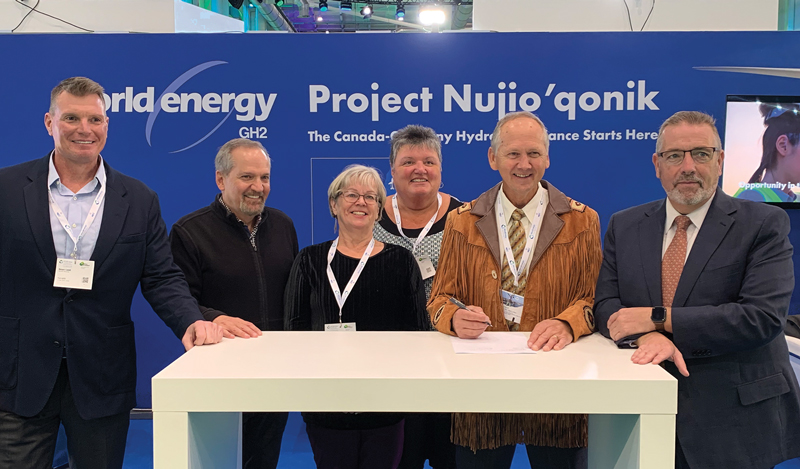Account Login
Don't have an account? Create One

Thanks to a consortium of common interests that span the globe, St. John’s, NL-based World Energy GH2 is poised to produce green hydrogen for global markets as soon as 2025.
The renewable energy company has officially launched a CAD $16 billion project to produce 250,000 metric tons of green hydrogen per year from a new facility powered by wind turbines on the west coast of Newfoundland and Labrador. Meanwhile, Canada has signed an agreement to supply Germany with the carbon-free fuel, signaling the birth of a promising green industry in this country and, according to Sean Leet, Managing Director and CEO of World Energy GH2, a strategic role for industry leaders in Atlantic Canada.
“This project—Canada’s first commercial green hydrogen facility—is first-of-its-kind, bringing together global leaders who are committed to reducing carbon emissions and providing the scale necessary to expand the reach of decarbonization efforts throughout the world,” he explained. “The project’s wind farms will supply three gigawatts of wind power to a plant that will manufacture green hydrogen.”
Harnessing Newfoundland and Labrador’s vast wind energy to split water (H2O) into hydrogen and oxygen through a process called electrolysis, World Energy GH2 will employ renewable power to produce green hydrogen which can be used as an immediate solution to decarbonization in hard-to-abate sectors.
In contrast, “grey hydrogen” is produced from fossil fuels and emits a high level of carbon; while “blue hydrogen” is produced in a similar way, generally from natural gas, and the carbon is stored using carbon capture technology.
The green hydrogen will be transported in the form of green ammonia which will allow the global delivery of clean, renewable power at scale. The project is expected to produce 1,800 direct construction jobs, 300 direct operations jobs and 3,500 indirect jobs.
According to research published in the International Journal of Hydrogen Energy last year, “Hydrogen has emerged as a promising climate-neutral energy carrier. More than 25 countries have published hydrogen roadmaps. Transition requirements in energy systems spotlight hydrogen due to its versatility. The development of a green hydrogen economy is seen as a significant contributor to achieving the climate goals set by the Paris Agreement.”
According to Leet, the goals for the World Energy GH2 project are also local. “This whole process needs to be inclusive and consultative, and the benefits for communities need to be clear. It’s crucial that the project—and the industry—provide value to communities in Newfoundland and Labrador and positions our province and Canada as global leaders in green energy.”
Consistent with that, Project Nujio’qonik (Mi’kmaw meaning “where the sand blows”) involves memoranda of understanding with Qalipu First Nation and the Town of Stephenville, NL. World Energy GH2 recently established a $10-million Community Vibrancy Fund for Project Nujio’qonik’s three current areas in Newfoundland and Labrador—the Town of Stephenville, the Port au Port Peninsula, and the Three Rivers/Flat Bay/Codroy Valley area, pending project approval.
Said Leet: “The fund will be paid over three years and equally divided across the project areas, commencing in accordance with permitting timelines. Once the project is underway, it will create significant economic activity. This initial, $10 million fund demonstrates our commitment to the people in the project areas, and it’s an investment in the communities in the time between construction and the first hydrogen production in 2025. We don’t want to wait for the revenue generating phase of the project to start directly benefiting communities.”
Added World Energy GH2 Director John Risley: “Atlantic Canada is positioned to be a global leader in the production of green hydrogen, but there is no time to waste. World Energy GH2 is thrilled to deliver tangible support to our friends in Europe who urgently need reliable sources of clean energy.”
Project Nujio’qonik aims to be Canada’s first commercial green hydrogen/ammonia producer created from 3+ gigawatts of wind energy in one of the world’s best wind resource regions.
Comment policy
Comments are moderated to ensure thoughtful and respectful conversations. First and last names will appear with each submission; anonymous comments and pseudonyms will not be permitted.
By submitting a comment, you accept that Atlantic Business Magazine has the right to reproduce and publish that comment in whole or in part, in any manner it chooses. Publication of a comment does not constitute endorsement of that comment. We reserve the right to close comments at any time.
Cancel
A great project. This will revitalize Bay St. George and Newfoundland in general. Green Energy is the way of the future, and World Energy GH2 is a leading contributor in the fight against global warming. All the best.
This is not a large project when compared to the 11 or 12 largest projects under development. There are projects in Quebec and Nova Scotia that project 43 Million Tons of H2 per year (each).
I should have included the source article: https://www.hydrogeninsight.com/production/impossible-dreams-the-11-biggest-green-hydrogen-projects-announced-around-the-world-so-far/2-1-1517618
I did a spreadsheet that suggests the kW per Ton of H2 figure is reasonable.